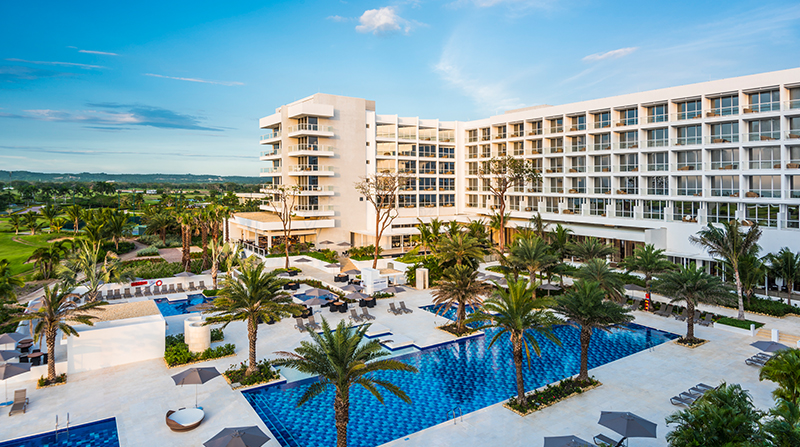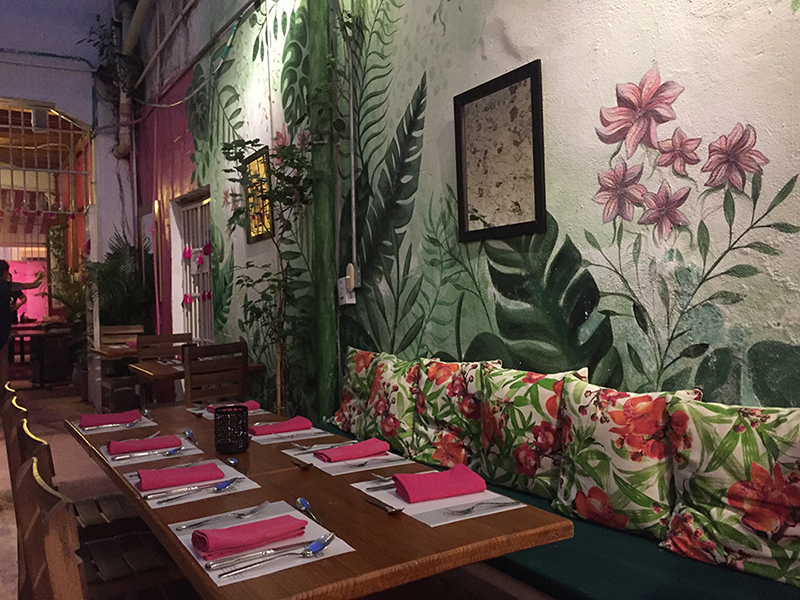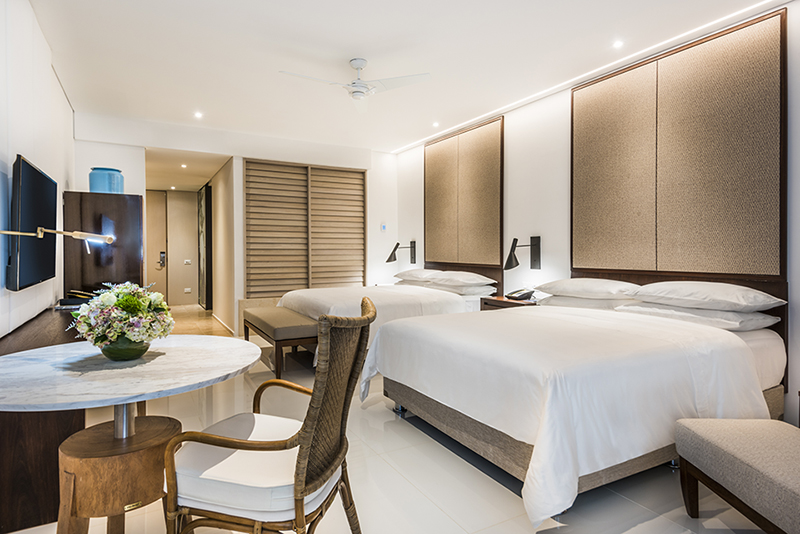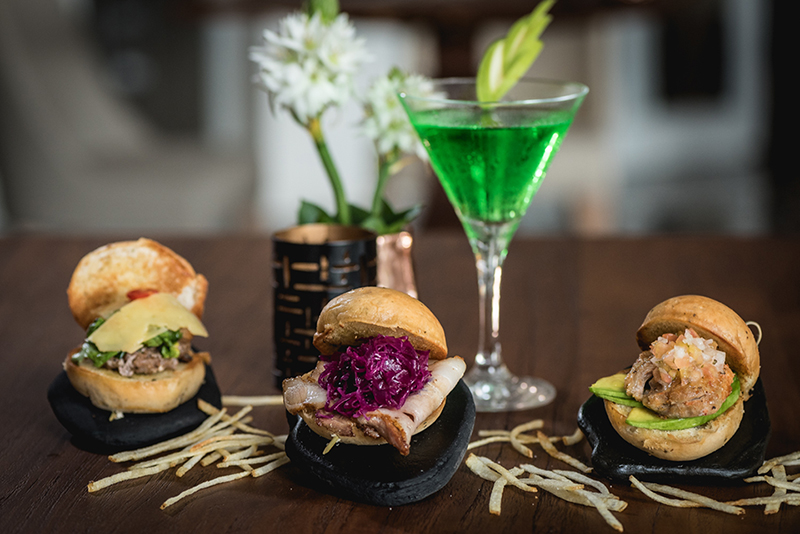
As you approach the new Conrad Cartagena, you’ll drive through tranquil countryside. And right after you encounter some grazing cows, the hotel’s bright white geometric façade emerges from the verdant surroundings.
The modern hotel stands alone in this secluded corner, but not for long. Despite its name, the Conrad resides about 20 miles north of Cartagena in a new town called Serena del Mar. The development is an effort to create a new hub for tourists outside of Cartagena’s congested Old City and accommodate the swelling local population.
The hotel marks the beginning for the sustainably designed coastal city. Its 30-year plan includes a hospital, the first satellite campus of Bogota’s University of the Andes, an 18-hole Robert Trent Jones II golf course, a marina, bike paths, schools and homes for all income levels. And 75 percent of Serena del Mar’s 2,500 acres will remain green. There’s even talk of moving the airport here. Signs around the area call it “la ciudad soñada,” the dream city.
Colombia as a whole has seen a surge in tourism — it’s grown more than 300 percent since 2006, according to Colombia Reports. So far this year, international visitors rose 33 percent over the same period in 2017, the Ministry of Commerce, Industry and Tourism says.
Conrad ushers in the brand’s first hotel in the country, which parent company Hilton is homing in on as a hot spot. “Colombia is ‘the’ place to be discovered in Latin America,” says Luis Perillo, vice president for sales and marketing for the Caribbean and Latin America at Hilton Worldwide.
Inside the Hotel
What distinguishes Conrad Cartagena from hotels in the Old City is that it sits on the beach. The property’s Karibana Beach Club stretches out across more than a half a mile of private sand dotted with loungers under shady palapas. If the toasty waters don’t entice you, a pool lies just beyond.
The hotel is all about the water — four other pools reside closer to the main resort under palm trees. One is reserved for the spa, a soothing gray-and-white-swathed space where post-massage you can rest on a chaise lounge in the relaxation room with a cup of mint-basil tea and peek at the pool through floor-to-ceiling windows.
And if you want more active pursuits, the TPC Cartagena at Karibana — South America’s first TPC golf course — winds along the Caribbean Sea near the beach club.
Inside the Conrad, 268 guest rooms and suites come with balconies that look out over the pools, golf course and sea. First-floor suites have their own draw: private plunge pools and spacious patios. All are bathed in a fresh white palette punctuated with vivid photos and screen doors from local artists. The tan travertine bathrooms hold separate soaking tubs and showers.
Among the seven food and drink options on the property, check out the library-themed Biblioteka, where fresh housemade ciabatta and rye rolls, along with beet and oregano butters, hide in a false book. Tomes line the stylish venue.
Flip to the main courses, where Asian, European and Latin American influences bind together in fine-dining dishes like duck magret with brevas in red wine, feta, gratin dauphinois, mushroom sauce and foie gras.
For breakfast, visit the hotel’s Adesso Tu for the Colombian plates. Our go-to was the arepas (griddled corncakes), which arrive with eggs, tomato, onion, Costeño cheese and puffy buñuelos (fried cheese-flavored dough balls).
When you want a nightcap, follow the live Cuban beats into lobby bar Son and Ron and peruse the specialty rum menu.

Interno. Credit: Jennifer Kester
Outside the Hotel
While you could loll at the luxurious hotel for the entire trip, one of Conrad Cartagena’s best amenities is its Stay Inspired itineraries. The specially curated one-, three- and five-hour experiences have you exploring Cartagena’s best sights and local haunts.
One of the excursions led us to Interno, a restaurant inside the San Diego women’s penitentiary. Fourteen inmates prepare and serve the food as part of a program to help them learn skills for reentry to society. We weren’t sure what to expect: Dining in a cell? Gruff convicts serving prison slop along with menacing glares?
After passing through a cell-like entryway, we were surprised to find a charming roofless restaurant with plant and flower murals, and neatly folded fuchsia napkins at wood tables. It looked like a hip little restaurant you’d find in Miami.
The prisoners were friendly, polite women with big fuchsia bows tied in their hair and black T-shirts. Our server Crystal hails from Florida and initially came to Colombia to pursue her singing career (she entertained us with a few impromptu bars from Alicia Keys’ “Girl on Fire”), but was vague on the details that landed her in San Diego as its sole American inmate.
Oh, and there was not an ounce of slop: the three-course menu was envisioned by some of the country’s top chefs. Tilapia ceviche in coconut milk with ripe banana was a standout starter, and tender Cartagena beef followed up as a satisfying entrée. Wine was flowing, but the coconut lemonade was refreshing on a steamy night.
https://www.instagram.com/p/BnXawnMBMDY/?taken-by=jennifer.kester
We could have lingered longer, but we had to scurry off to a private salsa class at Crazy Salsa. The energetic instructor made the hourlong session breeze by. After learning the basic moves, we were swaying and stepping to the beat on our own.
The final stop on our agenda was Absenta, an absinthe bar along the lovely Plaza San Diego. The bar’s warren of rooms exuded a wonderland-like vibe. In the foyer, tomes hung from the ceiling and pages served as wallpaper; book bindings plastered the bar. One room had top hats and upside-down chairs dangling from above, and another space’s walls were sprouting with leafy plants.
The cocktails were just as intoxicating as the ambiance. Mixologists displayed some showmanship to craft the absinthe tipples, firing up a blowtorch to melt a sugar cube on a slotted spoon into the glass of potent liquor. It was a fitting way to cap off a night in the Old City before heading back to the “dream city.”


